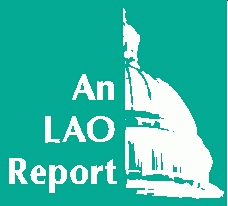
 |
Overview
of the
|
The Governor's Plan |
Major
Upward Revision to Revenues. Due to the
strong economy and stock market, revenues have improved
dramatically. The administration has raised its General
Fund revenue forecast by nearly $1.8 billion in
1997-98 and $2.5 billion in 1998-99 (a two-year
total of $4.2 billion). Major New Ongoing Commitments. The administration proposes two major ongoing commitments: (1) a two-step reduction in the state's vehicle license fee (VLF), which would reduce revenues by more than $3 billion annually when fully phased in, and (2) an over-appropriation of the Proposition 98 minimum guarantee by $500 million. One-Time Commitments. The administration also proposes to dedicate significant amounts of the new revenues for one-time purposes: (1) $1.2 billion on a variety of programs (primarily in resources and higher education) and (2) an increase in the reserve of $1.4 billion (although most of this would go towards funding the out-year cost of the VLF reduction). |
LAO Findings |
Revenues
Somewhat Overstated. Although we believe
that the Governor's revenue forecast is too high by a
half-billion dollars, the economy's underlying strength
should nevertheless produce strong revenue performance. One-Time Spending Addresses Important Needs. In our view, the Governor's plan wisely spends funds on one-time purposes that enhance the state's fiscal condition. Refocus New Proposition 98 Spending. If the state over-appropriates the guarantee, we believe the Legislature should spend the funds in ways that would achieve fundamental improvements in the school system. Specifically, we recommend the adoption of a new district accountability block grant and merit pay demonstration program. The VLF Proposal Has Major Long-Term Implications. While providing significant tax relief, the VLF proposal requires a major dedication of future resources. The budget will remain balanced only if the state enjoys continued economic growth and there are no new or expanded commitments in other areas of the budget. Even under these circumstances, growth in existing state programs will likely be constrained in future years. |
For the third year in a row, the May Revision reflects a major improvement in the state's fiscal picture. Strong economic growth and stock market-related increases in capital gains have produced major increases in tax receipts by nearly $1.8 billion in 1997-98 and $2.5 billion in 1998-99, for a two-year gain of $4.2 billion.
As shown in Figure 1, the Governor proposes to allocate these additional revenues among several areas. The major new proposals for ongoing commitments are a phased-in 75 percent reduction in the VLF and an increase in K-12 Proposition 98 spending.
His other proposals involve mostly one-time commitments for such purposes as an increase in the budget reserve, new funding for deferred maintenance in higher education, resources-related spending for the purchase of the Headwaters Forest and local flood control subventions, and other purposes (including capital outlay, an increase in funding for the local infrastructure bank, and various loan repayments).
Figure 2 shows the May Revision's projected revenues, expenditures, and reserves. It shows that revenues are projected to increase by 5.9 percent between the current and budget years, while expenditures are estimated to increase by 9.9 percent. The large percentage increase in General Fund expenditures partly reflects spending that would be needed to "backfill" the loss of local revenues that would result from the VLF reduction.
Reserves Up Sharply.
Under the Governor's revised budget plan, the General Fund will
close the current year with a reserve of nearly $2.1 billion
in 1997-98 and $1.6 billion in 1998-99. These new reserve
estimates are up sharply from the January reserve estimate of
about $300 million in both the current and budget years.
Much of the budget-year reserve would be needed to cover the
future year impacts of the proposed VLF reduction. Consequently,
these funds would not be available for traditional purposes of a
reserve, such as to cover unexpected cost increases or revenue
declines.
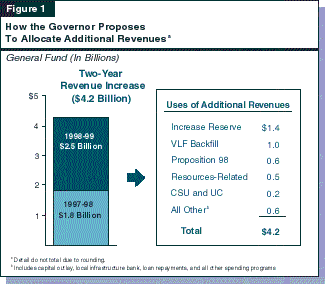
| Figure 2 | |||
| 1998 May Revision General Fund Condition | |||
| 1997-98 and 1998-99 (Dollars in Millions) |
|||
| 1997-98 | 1998-99 | Percent Change | |
| Prior-year fund balance | $907 | $2,520 | |
| Revenues and transfers | 54,645 | 57,847 | 5.9% |
| Total resources available | $55,552 | $60,367 | |
| Expenditures | $53,032 | $58,274 | 9.9% |
| Ending fund balance | $2,520 | $2,093 | |
| Other obligations | $445 | $445 | |
| Reserve | $2,075 | $1,648 | |
| Detail may not total due to rounding. | |||
Summary. While the administration's forecast for the U.S. economy has changed only modestly since January, its near-term forecast for California is stronger. This improved outlook largely reflects the recent strength in the state's economy, where employment and income have been growing at their strongest rates since the mid-1980s. The forecast continues to assume that some slowing will occur in the second half of 1998 due to the impact of Asia's economic problems on industries that export to that region. However, the state's economic momentum in early 1998 is expected to result in a higher level of employment and income through the budget year.
National Forecast. The updated forecast assumes that real U.S. Gross Domestic Product will slow from 2.9 percent in 1998 to 1.7 percent in 1999. Inflation is projected to remain low, with the Consumer Price Index increasing by just 1.8 percent in 1998 and 2.5 percent in 1999. The combination of slowing U.S. production and rising wages is expected to put a squeeze on U.S. profits. The May Revision forecast of pre-tax earnings is for a minor gain of 1.3 percent in 1998 and a decline of 0.2 percent in 1999.
California Forecast. Wage and salary employment is projected to increase 3.3 percent in 1998 and 2.9 percent in 1999, while personal income is forecast to grow by 7.2 percent this year and 5.7 percent next year. The estimate for personal income in 1998 is up nearly 1 percent from the January projection.
We believe that the administration's economic projections are reasonable in light of recent economic developments nationally and in California. The revised forecast is very similar to our updated May projections for employment, income, sales, and housing activity in the state.
The administration's revised revenue forecast is up substantially from its January budget forecast by nearly $1.8 billion in 1997-98 and $2.5 billion in 1998-99, or $4.2 billion for the two years combined (see Figure 3).
The fact that the budget-year gain exceeds that for the current year indicates that the administration views essentially all the factors causing the current-year gain as being ongoing. In terms of percentage growth, the May Revision predicts revenue growth of 11 percent in 1997-98 and 5.9 percent in 1998-99.
The figure indicates that nearly $3.6 billion or about 85 percent of the dramatic two-year revenue gain is attributable to stronger-than-expected personal income tax revenues. This, in turn, is assumed to be due in large part to capital gains.
Capital gains represent increases in the
value of assets (such as stocks) which are generally subject to
income taxation when sold. Figure 4 shows the trend in
California capital gains since the late 1980s. Through 1995,
these gains were in the general range of $20 billion
annually. Then, they abruptly departed from this relatively
stable trend, rising by over nearly 60 percent in 1996 and
by another 45 percent in 1997. This surge relates to the
striking stock market rise that has been experienced during the
1990s. In addition, federal tax rates on capital gains were
reduced during 1997, causing many taxpayers to accelerate the
realization of their gains.
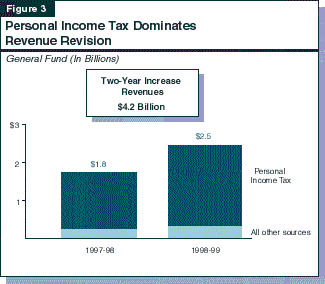
For 1998 and 1999, the administration is projecting continued increases in capital gains, expecting them to rise by 15 percent in 1998 and another 5 percent in 1999. As a result, capital gains would total over $58 billion in 1999, or more than two-and-one-half times their level just four years before.
Our updated revenue forecast is modestly below the Governor's by $50 million in the current year and $490 million in the budget year, or $540 million for the two years combined. This difference is only about one-half of one percent of total revenues estimated for the two years combined. However, it is a significant amount from a budgetary perspective.
Figure 5 shows that this
revenue-forecasting discrepancy is primarily due to the personal
income tax, where our two-year projection is $470 million
below the administration's. In particular, we believe that the
administration has "over-reached" in its capital gains
forecast.
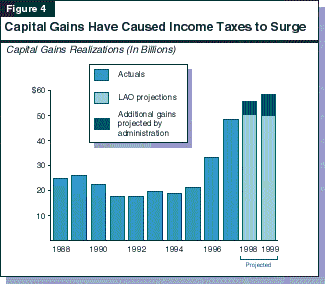
Capital Gains Forecast Is
Aggressive. As shown in Figure 4 earlier, the
administration is projecting that capital gains realizations will
reach nearly $56 billion in 1998 and over $58 billion
in 1999. Capital gains are very difficult to predict, and it is
possible that capital gains could reach these levels. However, as
Figure 4 shows, we think it is more likely that gains will
be in the range of $50 billion in these years.
Our forecast is still well above historical levels and a bit above 1997's strong performance. In fact, after adjusting for the behavioral effects of the 1997 federal capital gains tax rate changes, our estimate assumes a relatively strong underlying growth trend in gains15 percent in 1998 and 5 percent in 1999.
The difference in our capital gains forecasts is important in terms of the overall revenue outlook. Given that the average state tax rate applied to these gains is above 8 percent, the difference in our assumptions translate into a revenue difference of nearly $500 million in 1998-99.
Other Revenue Estimating Differences. Figure 5 shows that we also project $140 million less in bank and corporation tax revenues. This reflects both the recent softness in tax prepayments for this tax, and the general view of economists that corporate profit growth will only be modest in the near term.
| Figure 5 | |||
| LAO Differences From May Revision Revenue Forecast | |||
| (In Millions) | |||
| Revenue Source | 1997-98 | 1998-99 | Two-Year Total |
| Personal income tax | -$10 | -$460 | -$470 |
| Sales and use tax | -5 | 20 | 15 |
| Bank and corporation tax | -60 | -80 | -140 |
| All other sources | 25 | 30 | 55 |
| Totals | -$50 | -$490 | -$540 |
As noted earlier, a key element in the Governor's May Revision budget plan is to reduce the VLF levied on those individuals and businesses who register their vehicles in California. This section discusses the Governor's proposal, including background on the VLF, the proposal's specific provisions, its fiscal implications, and considerations for the Legislature.
The VLF is an annual fee on the ownership of a registered vehicle in California. Automobiles, motorcycles, pick-up trucks, commercial trucks and trailers, rental cars, and taxicabs are all subject to the VLF. Since 1935, the state has collected the fee in place of each county taxing vehicles as personal property. The VLF revenues are sent to cities and counties. About three-fourths of the revenues can be used for any purpose, with the remaining funds used to pay for "realignment" health and social services programs. In 1998-99, VLF revenues are expected to total over $3.9 billion.
The fee is calculated on the basis of the purchase price, regardless of whether a car is bought new or used. (Thus, a buyer of a used car pays the VLF based on the price paid when acquiring the carnet on the original price.) For each year the vehicle is owned, the fee paid declines in accordance with a statutory depreciation schedule to reflect the declining value of the vehicle. Since 1948, the tax rate has been set at 2 percent of this depreciated purchase price. Therefore, a vehicle owner annually pays 2 percent of the estimated current value of the vehicle. For an owner of an automobile, the average VLF paid is currently about $170.
As noted earlier, the Governor proposes to reduce the current 2 percent VLF tax rate. Beginning January 1, 1999, the rate would be reduced to 1 percent. Each owner's fee would therefore be cut in half. Then, beginning January 1, 2002, the rate would be halved again to 0.5 percent. Other vehicle fees such as vehicle registration fees, air quality fees, and commercial vehicle weight fees would not be affected by the change. The revenue losses resulting from the Governor's VLF proposal are shown in Figure 6 (2002-03 is the first full-year impact). Figure 7 compares VLF paid under current law and the Governor's proposal for a new $22,100 vehicle purchased in 1998 with the same owner through 2003.
| Figure 6 | |
| Fiscal Impact of Governor's VLF Proposal | |
| (Dollars in Billions) | |
| Year | Revenue Loss |
| 1998-99a | $1.0 |
| 1990-00 | 2.1 |
| 2000-01 | 2.2 |
| 2001-02b | 2.8 |
| 2002-03 | 3.6 |
| a Rate reduced to 1 percent on January 1, 1999. | |
| b Rate reduced to 0.5 percent on January 1, 2002. | |
| Figure 7 | |||
| Impact of Governor's VLF Proposal On A New Car Buyer | |||
| VLF on an Average-Priced New Car ($22,100)a | |||
| Year | Current Law | Governor's
Proposal |
Difference |
| 1998 | $442 | $442 | -- |
| 1999 | 398 | 199 | $199 |
| 2000 | 354 | 177 | 177 |
| 2001 | 309 | 155 | 155 |
| 2002 | 265 | 66 | 199 |
| 2003 | 221 | 55 | 166 |
| a Assumes a 1998 purchase and a single owner over period. | |||
The Governor proposes to hold local
governments and realignment "harmless" from the tax
cut. In order to pay local governments for lost VLF revenues, the
Governor would use the state's General Fund revenues (at annual
costs shown in Figure 6). The funds to repay local
governments would be continuously appropriated and would not need
to be approved in the annual budget process. This would not,
however, prevent the state from adjusting subventions in future
years. Because the Governor's proposal would not affect General
Fund tax revenues, it would have no impact on school funding
under Proposition 98. (For additional information on the
VLF, please see "A Perspective on the Vehicle License
Fee" in The 1998-99 Budget: Perspectives and Issues,
p.149.)
In reviewing the Governor's proposal to reduce the VLF, the Legislature should focus on the three basic issues which pertain to all tax-reduction proposals. These key issues are:
In general, reducing the VLF as a tax-cut option is a fairly straightforward, simple method of providing relatively broad-based tax relief. Its benefits to taxpayers would be roughly in proportion to their expenditures on automobiles. If a tax cut is desired, there also are a variety of other ways that a tax reduction of the magnitude of the Governor's VLF proposal could be achieved, each with its own unique characteristics. Several examples are summarized in Figure 8. Each of these options would provide broad-based tax relief equal to about $2 billion annually, which is the full-year cost of the initial 50 percent reduction in the VLF.
| Figure 8 | ||
| Alternative
Broad-Based Approaches To Reducing Taxes By $2 Billion Annually |
||
|
||
|
||
|
||
|
||
Clearly, the VLF proposal represents a major ongoing commitment of state funds that will have significant impacts on future state budgets. When fully phased in, the proposal will result in new annual General Fund expenditures of over $3 billion in order to backfill local revenues that will be lost because of the reduction. This amount is greater than the $2 billion (LAO estimate) to $2.5 billion (administration estimate) of ongoing revenue increases anticipated to be available in the budget year and beyond. Thus, the proposal will be workable only if:
Even if these conditions are met, the plan will be a "tight fit", and there will likely be little, if any, discretionary funds available in the future for new or expanded programs. And, of course, if the economy were to materially weaken, the plan would necessitate spending cuts because it leaves relatively little margin for error.
For these reasons, it will be important for the Legislature to carefully weigh the benefits and risks of this tax proposal, including how it "stacks up" against other budget priorities.
One-Time Spending Is Important Element in Plan. Given the large and expanding fiscal effects of the proposed VLF tax cut over time, the May Revision has proposed a fairly limited amount of additional spending for ongoing purposes relative to the January budget proposal. The one exception involves K-12 education, where the Governor proposes a $581 million increase for a variety of purposes. In other areas, the revised spending plan focuses mostly on one-time spending proposals, including many we have recommended to the Legislature. These include increasing direct appropriations for capital outlays, spending on deferred maintenance, and subventions to local governments to eliminate funds owed for flood control projects. Overall, of the $1.9 billion in additional spending proposed in the May Revision, roughly $1.2 billion is for one-time purposes.
The focus on high priority one-time needs is also an important element in the Governor's plan for reducing the VLF. Since one-time spending does not involve recurring spending in future years, it does not tie up funds in future budgets that would be necessary to accommodate the added annual costs of backfilling local government's losses relating to the proposed VLF reduction.
Although education funding has increased some from the January spending proposal, the administration's basic spending priorities remain relatively unchanged. In terms of major program areas, the May Revision plan includes above-average increases in education and corrections, and relatively smaller growth in health and social services. Figure 9 shows that, under the proposal, K-12 and higher education account for well-over one half of the budget, health and social services slightly more than one-fourth, and youth and adult corrections for about 8 percent. Other programs account for the remaining roughly 12 percent of the General Fund budget. In the following sections, we highlight the Governor's proposals in key program areas.
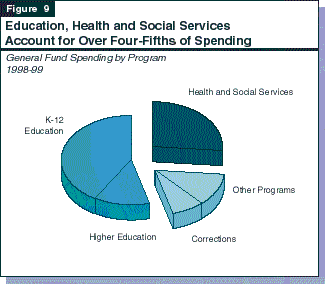
The May Revision proposes
$733 million in new spending for K-12 education. The
additional funds come from two primary sources. First, the
Governor proposes to recapture $267 million in school
district savings
resulting from the Public Employees' Retirement System (PERS)
rate reduction. Second, the Governor proposes to spend
$500 million more than the minimum funding guarantee under
Proposition 98 for K-14 education. The May Revision proposes
to spend $440 million of these additional funds for
K-12 education and $60 million for community college
programs.
These funds would support eight new programs and expand five existing K-12 programs. Figure 10 displays the major K-12 initiatives proposed in the May Revision. More than two-thirds of the new funds would support two new programs$250 million to purchase new mathematics textbooks for all K-12 students, and $230 million for the purchase of library materials and science equipment. The Governor also proposes $50 million for a new after-school incentive program (focused on high-poverty or high-crime schools).
| Figure 10 | |
| May
Revision Increases in K-12 Proposition 98 Spending |
|
| 1998-99 (Dollars in Millions) |
|
| Program | Amount |
| Mathematics textbooks | $250 |
| Library materials/science equipment | 230 |
| Longer school year (increase) | 55 |
| After-school incentive program | 50 |
| Remedial
mathematics and reading programs (increase) |
50 |
| Teacher training programs | 45 |
| Low-performing schools (increase) | 40 |
The proposal to appropriate significantly above the minimum funding guarantee required under Proposition 98 represents a major policy issue with long-term fiscal implications. Under Proposition 98, all appropriations to schools become part of the constitutionally required spending level in future years. The Legislature has always budgeted K-14 education funding levels at the minimum required under the Constitution (although it has sometimes over-appropriated unintentionally).
Because of the constitutional requirement for K-14 spending, the Legislature should consider two factors in making its decision to over-appropriate the Proposition 98 guarantee. First, can the state afford the long-term cost of a permanent increase in K-14 spending? While this determination can only be made in conjunction with other tax reduction and spending proposals, the state clearly has significant new ongoing resources that could be used for this purpose, if desired.
Second, the Legislature should consider whether the proposed spending plan for the additional K-14 funds has the potential to make significant improvements in the K-14 system. In our view, the Legislature should leverage any additional state funds above the guarantee to accomplish significant state goals in education. We think that beginning the process of improving school district incentives for good teaching and good administration is the most important use of additional funds for K-12 education at this time.
We do not believe the May Revision proposals for K-12 would have a significant impact on the success of the K-12 system. We see several problems. First, many of the proposals actually erode existing school district incentives for good administration by taking responsibility out of the hands of local decision-makers and placing the state in the responsible role. Does it make sense for all schools to purchase new mathematics textbooks next year? When the state is providing full funding for only that purpose, it reduces the likelihood that districts will ask that question.
Second, the proposals address specific issues without documenting the extent or severity of the problems the proposals intend to fix. While inadequate textbooks may be a problem in some districts, many districts do not experience a shortage. For this reason, we think the Legislature should provide funds in ways that allow greater local flexibility.
We recommend that the Legislature adopt a plan that uses the additional Proposition 98 funds to begin improving local incentives. Figure 11 displays the major elements of our recommendations. As the figure shows, our proposal includes $130 million to continue equalizing school district revenue limits.
| Figure 11 | ||
| LAO Recommended Uses For Additional Proposition 98 Funds | ||
| Provide $220 million for a District Accountability Block Grant Program. | ||
|
||
| Appropriate $30 million for a Merit Salary Demonstration Program. | ||
|
||
| Let School Districts Keep the $267 Million in PERS Savings. | ||
|
||
| Spend $130 Million to Equalize General Purpose Funding. | ||
|
||
The remaining three elements of our proposal would encourage districts to make important financial decisions and then hold them accountable for those actions. This is best illustrated by the District Accountability Block Grant, which would provide funds for textbooks, new teacher training, and facility improvements. If a district certified that it provides an adequate level of support in these areas, however, it would be free to spend these funds for other high-priority purposes. The Merit Pay Demonstration Program would encourage districts to reward their best teachers with bonuses or permanent increases in pay. In the long-run, we believe merit pay can play an important role in helping schools attract and reward good teachers. Finally, our proposal would let districts keep $267 million in PERS savings as a first step in giving districts control over retirement costs and benefits.
The budget proposes increases of $134 million for the University of California (UC) and $117 million for the California State University (CSU), primarily for one-time purposes. These include $85 million in each segment for deferred maintenance, instructional equipment, computer upgrades, and library materials, as well as additional funds for capital outlay. The May Revision also includes funds for additional UC students, an additional one-percent salary increase at CSU, and various other projects.
The May Revision includes a $70 million increase in community college funding in 1998-99 relative to the January budget. This includes a $50 million increase in the "Partnership for Excellence" program and a $13 million increase in the Economic Development Program.
Overall General Fund spending for health and social services programs is up about $121 million in the May Revision relative to the January budget. The updated plan includes significant savings related to lower-than-expected caseloads in California Work Opportunity and Responsibility to Kids (CalWORKs), Supplemental Security Income/State Supplementary Program (SSI/SSP), and Medi-Cal. Offsetting these savings, however, are additional costs associated with new policy proposals. These include $107 million in CalWORKs for increased county fiscal incentive payments; a $50 million set-aside for program initiatives involving foster care; a $61 million increase for the restoration of the 2.84 percent state cost-of-living adjustment for SSI/SSP recipients; and a $25 million increase in the Medi-Cal program for a Central Valley burn and trauma center. (Savings and costs in CalWORKs include federal block grant funds.)
The May Revision contains relatively modest changes in the Department of Corrections budget. Slower growth in inmate populations has resulted in caseload savings in both the current and budget years. These savings have been partly offset by additional county reimbursements for the costs of detaining parole violators in local jails pending parole revocation hearings.
The May Revision provides slightly more than $400 million in mostly one-time funds for resources-related projects. These include $130 million for the state's share of the cost to acquire the Headwaters Forest and $172 million to pay off funds owed to local agencies for the state share of costs for various flood control projects. The May Revision also includes $50 million for the Air Resources Board to administer a grant program aimed at reducing emissions from heavy duty diesel engines found in trucks, locomotives, ships, and equipment.
Infrastructure Bank. The January budget included $50 million from the General Fund for initial capitalization of the Infrastructure and Economic Development Bank. The May Revision would provide an additional $100 million in funds for this purpose.
Employee Compensation.
The January budget proposal provided funds for the equivalent of
a 3-percent statewide employee cost-of-living increase. The May
Revision proposes to add $51.1 million (General Fund) for
employee compensation. The administration, however, dedicates
these funds for: (1) an additional 3 percent salary increase
(effective November 1, 1998) for public safety employees in four
specified bargaining units and
(2) recruitment and retention increases for unspecified job
classifications.
Given the state's improved fiscal condition, the Legislature has a special opportunity to enact a budget that reflects its spending and taxation priorities. In addition to the normal challenges that are involved in crafting a budget, the May Revision raises several specific issues that the Legislature will have to address in the weeks ahead. One involves the Governor's tax cut proposal, including its financial feasibility, given other competing priorities. A second involves the allocation of the significant amount of additional resources to educational programs which the Governor proposes. The Legislature's decisions regarding such issues will be among the most important that it makes this year, and will have an impact on future state budgets.
| Acknowledgments This report was prepared by Brad Williams and Jon David Vasché, with contributions from Paul Warren, Michael Cohen, and many others in the office. For questions, contact the authors at 324-4942. The Legislative Analyst's Office (LAO) is a nonpartisan office which provides fiscal and policy information and advice to the Legislature. | LAO Publications
To request publications call (916) 445-2375. |